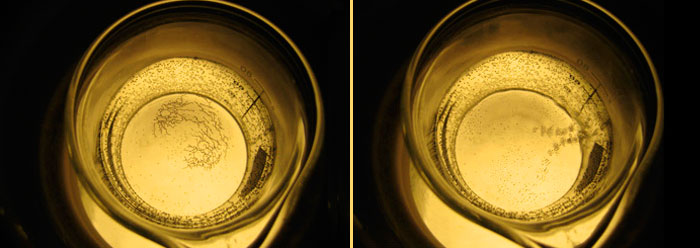Researchers at Argonne National Laboratories have observed nickel filings ordering into rows atop a special fluid. With precisely structured electromagnetic fields surrounding them, the snake-like rows undulated in their beakers. The magnetically-motivated metal’s meanderings appeared so lifelike that Wired Science writer Alexis Madrigal suggested the tiny nickel trains can provide “clues about how life originally organized itself.”1
A report on these magnetic “swimmers” was recently published in Physical Review Letters. In their paper posted on the Argonne National Laboratory website, the researchers stated:
Apparently, as the frequency of the magnetic field is increased, the snake develops highly asymmetric vortex structure. One pair of the vortices associated with one of the snake's tails becomes stronger than another meaning that one of the “engines" becomes more powerful. Resulting net difference in the engines power propels the snake.2
This strange phenomenon is seriously being entertained by some as a model for the self-organization of inanimate matter, with possible implications for the origin of life. Wired Science suggested that “perhaps, by studying this simple system, they can understand what [Argonne physicist Igor] Aronson calls ‘the fundamentals of self assembly, how nature can organize itself into ordered states.’”1 Instead of natural self-assembly, this “simple system” clearly demonstrates the distinct qualitative differences between ordered systems, like the nickel-filings train, and complex ordered systems, like life.
Evolutionary biochemist Jeffrey Wicken stated in 1979 that “whereas ordered systems are generated according to simple algorithms and therefore lack complexity, organized systems must be assembled element by element according to an external ‘wiring diagram’ with a high information content.”3
The nickel “snakes” of the Argonne studies, while more ordered than randomly scattered bits of metal, were not organized according to a specified plan. They were merely ordered by uniquely tuned, external electromagnetic fields acting on the inherent properties of the metal. The machinery of life does not simply have a greater amount of the same kind of order that the nickel snakes had. Life is different on a qualitative, not just quantitative, level. The machinery of life is organized according to massive “wiring diagrams.” That is, living cells consist of an unlikely arrangement of parts that are specified to precise functions. Moreover, an array of hundreds of these machines of life must all be pre-specified to work properly as well as inter-relationally in order to sustain any viable life form.
Writhing bits of electromagnetically-stimulated metal, like atoms in a crystal, are ordered. However, they are not specified. Rather than providing clues to “how life originally organized itself,” this research illustrates the utter inadequacy of natural forces alone to provide the information required to specify life. That information must therefore have come from a source outside of the natural universe. It is legitimate, then, both scientifically and logically to acknowledge the One by whom “were all things created, that are in heaven, and that are in earth.”4
References
- Madrigal, A. Metal Bits Self-Assemble Into Lifelike Snakes. Wired Science. Posted on blog.wired.com March 5, 2009, accessed March 24, 2009.
- Snezhko, A. et al. 2009. Self-Assembled Magnetic Surface Swimmers. Physical Review Letters. 102 (11): 118103. Pre-published version posted on mti.msd.anl.gov, the website of the Materials Theory Institute of the Argonne National Laboratory.
- Wicken, J. S. 1979. The generation of complexity in evolution: A thermodynamic and information-theoretical discussion. Journal of Theoretical Biology. 77 (3): 349.
- Colossians 1:16.
Image Credit: Betsy Mason/Wired.com
* Mr. Thomas is Science Writer at the Institute for Creation Research.
http://www.icr.org/article/metal-snakes-fall-far-short-life/
